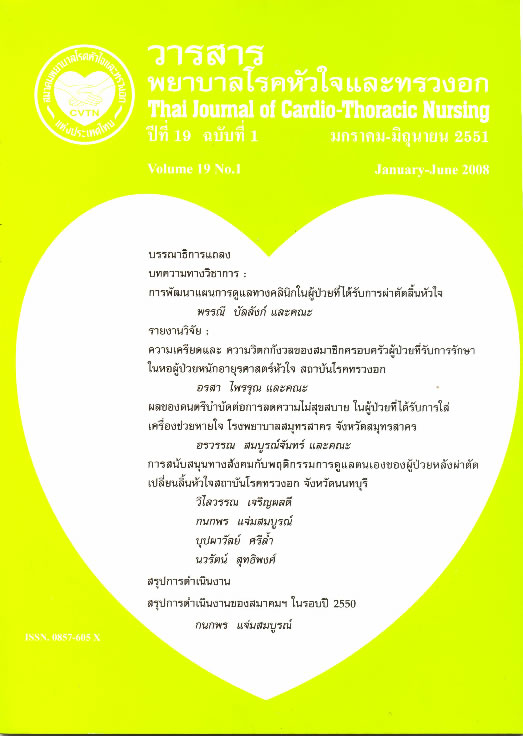การพัฒนาแผนการดูแลทางคลีนิคในผู้ป่วยที่ได้รับการผ่าตัดลิ้นหัวใจ
Keywords:
แผนการดูแลทางคลินิก, ผ่าตัดลิ้นหัวใจ, จำนวนวันนอนในโรงพยาบาล, ค่าใช้จ่าย, Clinical Pathway, Cardiac Valve, Surgery Length of Stay, Cost of careAbstract
บทคัดย่อ
การศึกษาครั้งนี้มีวัตถุประสงค์ เพื่อพัฒนาแผนการดูแลทางคลินิกในผู้ป่วยที่ได้รับการผ่าตัดลิ้นหัวใจ โดยใช้รูปแบบการใช้หลักฐานเชิงประจักษ์ของ Soukup (2000) เป็นกรอบแนวคิดในการดำเนินงาน ประกอบด้วย การวิเคราะห์และระบุปัญหาที่ต้องการแก้ไข สืบค้นหลักฐานเชิงประจักษ์ การประเมินระดับความน่าเชื่อถือ และความเป็นไปได้ในการนำหลักฐานเชิงประจักษ์ไปใช้ แผนการดูแลทางคลินิกที่พัฒนาขึ้นได้จากการสังเคราะห์งานวิจัยจำนวน 1 8 เรื่อง สาระที่ได้รับจากหลักฐานเชิงประจักษ์ คือ แผนการดูแลทางคลินิกที่เกิดจากการประสานความร่วมมือของทีมสหสาขาวิชาชีพมีการกำหนดกิจกรรมต่าง ๆ ที่พยาบาลและ/หรือทีมสหสาขาวิชาชีพ ต้องกระทำในแต่ละวันหรือแต่ละช่วงเวลา มีการบันทึกความแปรปรวนที่ทำให้แผนการ ดูแลทางคลินิกไม่สามารถดำเนินไปตามเป้าหมายที่คาดหวัง ผลจากการวิเคราะห์และสังเคราะห์หลักฐานเชิงประจักษ์ ได้นำมาพัฒนาแผนการดูแลทางคลินิกโดยครอบคลุมตั้งแต่ระยะก่อนผ่าตัด และระยะหลังผ่าตัด รวมไปถึงการวางแผนจำหน่าย โดยมีจำนวนวันนอนในโรงพยาบาลประมาณ 9 วัน โดยเป้าหมายสำคัญ คือ การดูแลที่ให้ประโยชน์สูงสุดต่อผู้ป่วย เป็นระบบ มีความครอบคลุม ต่อเนื่องและได้มาตรฐาน โดยคำนึงถึง การใช้ทรัพยากรที่มีอยู่อย่างมีประสิทธิภาพ คุ้มค่า คุ้มทุน แผนการดูแลทางคลินิกที่พัฒนาฃื้น ได้รับการ ตรวจสอบจากผู้ทรงคุณวุฒิ จำนวน 7 ท่าน และได้นำมาปรับปรุงแก้ไข ให้เหมาะสมในการนำไปใช้ต่อไป จากการศึกษาในครั้งนี้มีข้อเสนอแนะคือ ควรนำไปใช่ในการปฏิบัติตามสถานการณ์จริง โดยมุ่งเน้น ความร่วมมือของทีมสหสาขาวิชาชีพ ควรทำการศึกษาวิจัยเพื่อประเมินผลลัพธ์ พัฒนาและปรับปรุงอย่างต่อเนื่องตามความรู้ใหม่ๆ ที่เพิ่มขึ้น อีกทั้งควรนำไปพัฒนาเพื่อใช้ในการดูแลผู้ป่วยที่ได้รับการผ่าตัดหัวใจกลุ่มอื่นๆ ต่อไป
คำสำคัญ : แผนการดูแลทางคลินิก, ผ่าตัดลิ้นหัวใจ, จำนวนวันนอนในโรงพยาบาล, ค่าใช้จ่าย
Abstract
This study was aimed to develop a clinical pathway in cardiac valve surgery patients by utilizing the evidence based practice of a model devised by Soukup (2000) as a framework. The working steps consisted of analyzing and identifying problems, searching evidence, and assessing the creditability level and feasibility of implementation. The established clinical pathway was derived from the analysis of 18 research papers relating to cardiac valve surgery patients. This included identifying the daily and periodical activity of nurses and multi-disciplinary teams and identifying obstacles to their work. The results of the analysis of the evidence were used for improving the clinical pathway through the pre-operative phase to post-operative phase including discharge planning. The ideal length of stay was set as 9 days and the crucial goals were optimal outcomes of care for patients, including systematic, complete, continuing, and standardized care and concern about cost-effectiveness and proper resource utilization. The developed clinical pathway was validated by 7 experts and adjusted for better application. It is recommended that the developed clinical pathway: 1) should be implemented in actual situations; 2) should be continuously developed with research conducted to evaluate the outcomes of following this clinical pathway; 3) should be adjusted following new knowledge; and 4) should be extended to other groups of cardiac surgery patients.
Keywords : Clinical Pathway, Cardiac Valve, Surgery Length of Stay, Cost of care
Downloads
How to Cite
Issue
Section
License
บทความนี้ยังไม่เคยตีพิมพ์หรืออยู่ในระหว่างส่งไปตีพิมพ์ในวารสารอื่น ๆ มาก่อน และกองบรรณาธิการขอสงวนสิทธิ์ในการตรวจทาน และแก้ไขต้นฉบับตามเกณฑ์ของวารสาร ในกรณีที่เรื่องของท่านได้ได้รับการตีพิมพ์ในวารสารฉบับนี้ถือว่าเป็น ลิขสิทธิ์ของวารสารพยาบาลโรคหัวใจและทรวงอก






